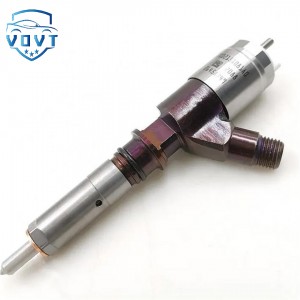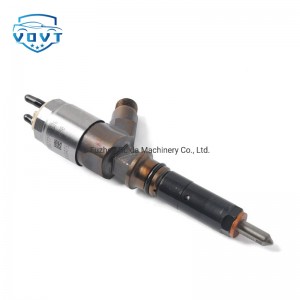New High Quality Diesel Injector 187-6549 203-7685 208-9160 10R-1264 212-3464 10R-0725 For CAT C12
Products Description
| Reference. Codes | C12 |
| Application | C12 |
| MOQ | 4PCS |
| Certification | ISO9001 |
| Place of Origin | China |
| Packaging | Neutral packing |
| Quality Control | 100% tested before shipment |
| Lead time | 7~10 working days |
| Payment | T/T, L/C, Paypal, Western Union, MoneyGram or as your requirement |
Study on the Characteristics of Diesel Engine Injector
One of the biggest differences between diesel engines and gasoline engines is the way fuel is injected. Gasoline engines usually inject fuel in the intake manifold at a pressure of only a few megapascals; while in order to fully burn the fuel in the high-temperature and high-pressure cylinder, the diesel engine can inject fuel at a pressure of 100-200 megapascals, which is equivalent to the power of a high-pressure water gun at close range! Under such high pressure, the injector is like a precise "sculptor", "carving" the fuel into micron-sized droplets and evenly distributing them in the combustion chamber.
How does it do it?
There is a precise "small valve" inside the injector - the needle valve, which is controlled by a solenoid coil. When the diesel engine control unit (ECU) issues an instruction, the solenoid coil generates magnetic force to suck up the needle valve, and the high-pressure fuel is ejected from the spray hole at high speed. The diameter of the spray hole is only 0.1-0.3 mm, which is equivalent to the thickness of a hair, but it can split the fuel into droplets with a diameter of 50-100 microns (not much larger than bacteria), allowing the fuel and air to be fully mixed to achieve efficient combustion.
The core mission of the injector is to allow the fuel to participate in combustion in the best form. There are two key indicators here: 1. Atomization fineness The finer the fuel atomization, the larger the area of contact with the air, and the more complete the combustion. Imagine that the fine mist sprayed from a watering can is easier to wet the ground than a water column - the atomization effect of the injector directly affects the "combustion efficiency" of the fuel. If the atomization is poor, the unburned fuel will be discharged as black smoke, which will waste energy and pollute the environment. 2. Spray shape Different diesel engine combustion chambers have different shapes (such as ω type, spherical type), and the injector needs to "tailor" the angle and range of the spray. For example, the diesel engine of a heavy truck needs the spray to run through the entire combustion chamber, while the diesel engine of a car needs the spray to be concentrated near the spark plug. If the spray shape is unreasonable, the fuel may be sprayed onto the cylinder wall to form carbon deposits, or the oxygen cannot be fully utilized, resulting in incomplete combustion. In the spray hole of the injector, there is a "microscopic battlefield" that is invisible to the naked eye - the mesoscopic scale fuel flow. When high-pressure fuel flows through a narrow nozzle, the pressure suddenly drops, which produces a large number of bubbles. When these bubbles burst, they release energy. This is the phenomenon of cavitation. Positive side: moderate cavitation can help the fuel break into finer droplets, just as the bubbles produced by shaking carbonated drinks can accelerate the mixing of liquids. Negative side: Excessive cavitation will impact the inner wall of the nozzle like a "micro bomb", causing wear and even corrosion, affecting the life of the injector.
In addition, the roughness of the inner surface of the injector is also crucial. If the inner wall of the nozzle is not smooth enough, turbulence will occur when the fuel flows, resulting in uneven fuel injection from each nozzle. Just like water flowing through a rough pipe will produce vortices, a rough inner wall will make the fuel "take a detour", ultimately affecting the stability of combustion.
In order to optimize the performance of the injector, scientists are working on two aspects:
1. Material and process upgrade
Use wear-resistant silicon nitride ceramics, diamond coatings and other materials to manufacture the spray holes to resist cavitation wear; through laser drilling and electrochemical polishing technology, the roughness of the inner wall of the spray hole is controlled below 0.1 microns (equivalent to 1/600 of a hair), allowing the fuel flow to be smoother.
2. Intelligent control technology
The new generation of injectors is equipped with pressure sensors and temperature sensors, which can feedback data to the ECU in real time to achieve "dynamic adjustment". For example, the injection volume is automatically increased during cold start, and the injection time is extended when climbing, just like installing a "smart brain" on the injector.
With the increasingly stringent environmental regulations (such as China's National Seven Standard), injectors are moving towards higher pressure (above 300 MPa), finer atomization (below 20 microns), and more intelligent control. In the future, the injector may be able to automatically adjust the spray pattern according to the real-time road conditions, so that the diesel engine can "eat less and do more" under various working conditions, contributing to energy conservation and emission reduction.
From micron-level spray holes to precise atomization under high pressure, diesel engine injectors interpret the power of technology with extreme precision. This small component is not only a masterpiece of mechanical engineering, but also a microcosm of human pursuit of efficiency and environmental protection. The next time you see a diesel car driving smoothly, think about the "dancing" injector inside it - it is countless such "small innovations" that are driving the world towards a green future.




















